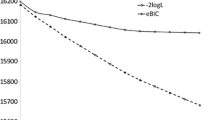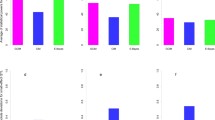Abstract
In this article, we successfully apply the novel model selection method, Bayesian composite model space approach which has been used to map quantitative trait loci (QTL) for allelic substitution model, to map QTL for variance component model. The novel model selection approach has two advantages compared to the reversible jump Markov chain Monte Carlo method. Firstly, it mixes well due to the fixedness of the model dimension; secondly, it can map multiple QTL with higher power especially in genome-wide QTL mapping; finally, in the new method, it is also easy to incorporate our prior information about the variance components, which may bring precise estimate for variance components. A series of simulation experiments were conducted to demonstrate the general characters of the proposed method. The computer program is written in FORTRAN language, which is also built into a software “BayesMapQTL”, and they also can be used for real data analysis and are available for request.




Similar content being viewed by others
References
Almasy L, Blangero J (1998) Multipoint quantitative-trait linkage analysis in general pedigrees. Am J Hum Genet 62:1198–1211. doi:10.1086/301844
Amos CI (1994) Robust variance-components approach for assessing genetic linkage in pedigrees. Am J Hum Genet 54:535–543
Banerjee S, Yandell BS, Yi NJ (2008). Bayesian QTL mapping for multiple traits. Genetics. doi:10.1534/genetics.108.088427
Browne WJ (1998) Applying MCMC Methods to multi-level models. Ph.D. Dissertation, Department of Mathematical Sciences, University of Bath, Bath
Fang M, Jiang D, Gao HJ, Sun DX, Yang RQ, Zhang Q (2008a) A new Bayesian automatic model selection approach for mapping quantitative trait loci under variance component model. Genetica. doi:10.1007/s10709-008-9291-5
Fang M, Jiang D, Pu LJ, Gao HJ, Ji P, Wang HY, Yang RQ (2008b) Multitrait analysis of quantitative trait loci using Bayesian composite space approach. BMC Genetics 9:48. doi:10.1186/1471-2156-9-48
Fulker DW, Cardon LR (1994) A sib-pair approach to interval mapping of quantitative trait loci. Am J Hum Genet 54:1092–1103
Gaffney PJ (2001) An efficient reversible jump Markov chain Monte Carlo approach to detect multiple loci and their effects in inbred crosses. Ph.D. Dissertation, Department of Statistics, University of Wisconsin, Madison, WI
Gilbert H, Le Roy P (2003) Comparison of three multitrait methods for QTL detection. Genet Sel Evol 35:281–304. doi:10.1051/gse:2003009
Gilbert H, Le Roy P (2004) Power of three multitrait methods for QTL detection in crossbreed populations. Genet Sel Evol 36:347–361. doi:10.1051/gse:2004005
Godsill SJ (2001) On the relationship between MCMC model uncertainty methods. J Comput Graph Stat 10:230–248. doi:10.1198/10618600152627924
Goldgar DE (1990) Multipoint analysis of human quantitative genetic variation. Am J Hum Genet 47:957–967
Green PJ (1995) Reversible jump Markov chain Monte Carlo computation and Bayesian model determination. Biometrika 82:711–732. doi:10.1093/biomet/82.4.711
Haseman JK, Elston RC (1972) The investigation of linkage between a quantitative trait and a marker locus. Behav Genet 2:3–19. doi:10.1007/BF01066731
Hastings WK (1970) Monte Carlo sampling methods using Markov chains and their applications. Biometrika 57:97–109. doi:10.1093/biomet/57.1.97
Heath SC (1997) Markov chain Monte Carlo segregation and linkage analysis for oligogenic models. Am J Hum Genet 61:748–760. doi:10.1086/515506
Jiang C, Zeng Z-B (1995) Multiple trait analysis of genetic mapping for quantitative trait loci. Genetics 140:1111–1127
Kass RE, Raftery AE (1995) Bayes factors. J Am Stat Assoc 90:773–795. doi:10.2307/2291091
Liu J, Liu Y, Liu X, Deng H-W (2007) Bayesian mapping of quantitative trait loci for multiple complex traits with the use of variance components. Am J Hum Genet 81:304–320. doi:10.1086/519495
Mähler M, Most C, Schmidtke S, Sundberg JP, Li R, Hedrich HJ, Churchill GA (2002) Genetics of colitis susceptibility in IL-10-deficient mice: backcross versus F2 results contrasted by principal component analysis. Genomics 80:274–282. doi:10.1006/geno.2002.6840
Mangin B, Thoquet P, Grimsley N (1998) Pleiotropic QTL analysis. Biometrics 54:88–99. doi:10.2307/2533998
Metropolis NA, Rosenbluth W, Rosenbluth MN, Teller AH, Teller E (1953) Equation of state calculations by fast computing machines. J Chem Phys 21:1087–1091. doi:10.1063/1.1699114
Plummer M, Best N, Cowles K, Vines K (2008) Coda: output analysis and diagnostics for MCMC, R package version 0.13-2
Roberts GO, Rosenthal JS (2001) Optimal scaling for various Metropolis–Hastings algorithms. Stat Sci 16(4):351–367. doi:10.1214/ss/1015346320
Satagopan JM, Yandell BS (1996) Estimating the number of quantitative trait loci via Bayesian model determination. Special contributed paper session on genetic analysis of quantitative traits and complex diseases, Biometric Section, Joint Statistical Meetings, Chicago
Satagopan JM, Yandell BS, Newton MA, Osborn TG (1996) A Bayesian approach to detect quantitative trait loci using Markov chain Monte Carlo. Genetics 144:805–816
Seaton S, Haley CS, Knott SA, Kearsey M, Visscher PM (2002) QTL Express: mapping quantitative trait loci in simple and complex pedigrees. Bioinformations 18(2):339–340. doi:10.1093/bioinformatics/18.2.339
Sillanpää MJ, Arjas E (1998) Bayesian mapping of multiple quantitative trait loci from incomplete inbred line cross data. Genetics 148:1373–1388
Stephens DA, Fisch RD (1998) Bayesian analysis of quantitative trait locus data using reversible jump Markov Chain Monte Carlo. Biometrics 54:1334–1347. doi:10.2307/2533661
Wang H, Zhang YM, Li X, Masinde GL, Mohan S et al (2005) Bayesian shrinkage estimation of quantitative trait loci parameters. Genetics 170:465–480. doi:10.1534/genetics.104.039354
Xu S (2003) Estimating polygenic effects using markers of the entire genome. Genetics 163:789–801
Xu S (2007) Derivation of the shrinkage estimates of quantitative trait locus effects. Genetics 177:1255–1258. doi:10.1534/genetics.107.077487
Xu S, Atchley WR (1995) A random model approach to interval mapping of quantitative trait loci. Genetics 141:1189–1197
Xu S, Gessler DD (1998) Multipoint genetic mapping of quantitative trait loci using a variable number of sibs per family. Genet Res 71:73–83. doi:10.1017/S0016672398003115
Xu C, Li Z, Xu S (2005) Joint mapping of quantitative trait loci for multiple binary characters. Genetics 169:1045–1059. doi:10.1534/genetics.103.019406
Yang RQ, Xu S (2007) Bayesian shrinkage analysis of quantitative trait loci for dynamic traits. Genetics 176:1169–1185. doi:10.1534/genetics.106.064279
Yi N (2004) A unified Markov chain Monte Carlo framework for mapping multiple quantitative trait loci. Genetics 167:967–975. doi:10.1534/genetics.104.026286
Yi N, Xu S (2000) Bayesian mapping of quantitative trait loci under the identity-by-descent-based variance component model. Genetics 156:411–422
Yi N, George V, Allison DB (2003a) Stochastic search variable selection for identifying multiple quantitative trait loci. Genetics 164:1129–1138
Yi N, Xu S, Allison DB (2003b) Bayesian model choice and search strategies for mapping interacting quantitative trait loci. Genetics 165:867–883
Yi N, Yandell BS, Churchill GA, Allison DB, Eisen EJ, Pomp D (2005) Bayesian model selection for genome-wide epistatic quantitative trait loci analysis. Genetics 170:1333–1344. doi:10.1534/genetics.104.040386
Yi N, Shriner D, Banerjee S, Mehta T, Pomp D, Yandell BS (2007a) An efficient Bayesian model selection approach for interacting quantitative trait loci models with many effects. Genetics 176:1865–1877. doi:10.1534/genetics.107.071365
Yi N, Banerjee S, Pomp D, Yandell BS (2007b) Bayesian mapping of genomewide interacting quantitative trait loci for ordinal traits. Genetics 176:1855–1864. doi:10.1534/genetics.107.071142
Zhang YM, Xu S (2005) Advanced statistical methods for detecting multiple quantitative trait loci. Recent Res Dev Genet Breed 2:1–23
Acknowledgments
We thank two anonymous reviewers for their criticisms which have greatly improved the presentation of the manuscript.
Author information
Authors and Affiliations
Corresponding author
Additional information
Edited by David Allison.
Appendix
Appendix
Update the covariate effects
We assume the prior distribution of the covariate effects β follow multivariate normal distribution, \( {\varvec{\beta}}\sim N({\varvec{\beta}}_{0} ,{\mathbf{V}}_{0} ) \) with hyper-parameter β 0 and V 0, then the efficient Gibbs sampling approach can be used to update the covariate effects. The posterior distribution of it follows multivariate normal distribution,
where, \( {\bar{\varvec{\beta }}} = \left( {{\mathbf{X}}^{T} {\mathbf{V}}^{ - 1} {\mathbf{X}} + {\mathbf{V}}_{{_{0} }}^{ - 1} } \right)^{ - 1} \left( {{\mathbf{X}}^{T} {\mathbf{V}}^{ - 1} {\mathbf{y}} + {\mathbf{V}}_{{_{0} }}^{ - 1} {\varvec{\beta}}_{0} } \right),\,{\mathbf{V}}_{{\varvec{\beta}}} = \left( {{\mathbf{X}}^{T} {\mathbf{V}}^{ - 1} {\mathbf{X}} + {\mathbf{V}}_{{_{0} }}^{ - 1} } \right)^{ - 1} . \)
Update the polygenic variance and the residual variance
The approaches of updating the polygenic variance \( \sigma_{A}^{2} \) and the residual variance \( \sigma_{e}^{2} \) are very similar to that of updating the QTL variance. We also use Browne’s approach to generate the new value and then accept it according to the acceptance probability. The acceptance rate for updating the polygenic variance
where, \( p(\sigma_{A}^{2} \left| {s_{A}^{2} } \right.)\sim {\text{Inv}} - {{\upchi}}^{2} (\omega_{A} ,s_{A}^{2} ) \propto s_{A}^{{\omega_{A} }} (\sigma_{A}^{2} )^{{ - (\omega_{A} /2 + 1)}} \cdot \exp \left( { - \omega_{A}^{{}} s_{A}^{2} /(2\sigma_{{^{A} }}^{2} )} \right) \), and
The acceptance rate for updating the residual variance
where, \( p(\sigma_{e}^{2} \left| {s_{e}^{2} } \right.)\sim {\text{Inv}} - {{\upchi}}^{2} (\omega_{e} ,s_{e}^{2} ) \propto s_{e}^{{\omega_{e} }} (\sigma_{e}^{2} )^{{ - (\omega_{e} /2 + 1)}} \cdot \exp \left( { - \omega_{e}^{{}} s_{e}^{2} /(2\sigma_{{^{e} }}^{2} )} \right) \), and
Update QTL position
The proposal position is moved around the old one, \( \lambda_{j}^{*} = \lambda_{j}^{{}} + d \), where d is a random number which is sampled from uniform distribution with bound −kcM and kcM, where k is a predetermined tuning parameter, equal to 1 for chromosome segment analysis and 20 for genome-wide scan in our study. The new position is accepted with probability equal to min (1, r), and r is shown in Table 1.
Rights and permissions
About this article
Cite this article
Fang, M., Liu, S. & Jiang, D. Bayesian Composite Model Space Approach for Mapping Quantitative Trait Loci in Variance Component Model. Behav Genet 39, 337–346 (2009). https://doi.org/10.1007/s10519-009-9259-y
Received:
Accepted:
Published:
Issue Date:
DOI: https://doi.org/10.1007/s10519-009-9259-y




